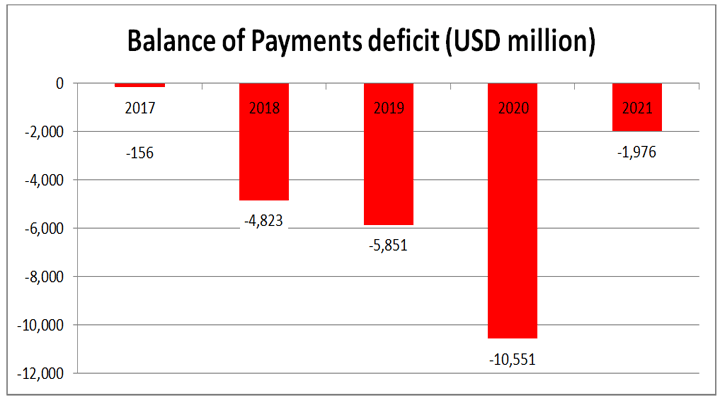Balance of Payments deficit
drops 81 percent to $2 billion
Driven by less imports, BDL subsidies more tourism, FX liquidity plus SDRs
| Share |
|

|
|

|
|
|
|
The deficit in the Balance of Payments (BoP) narrowed by 81 percent to $2 billion in 2021 from $10.6 billion in the previous year, according to Central Bank (BDL) data.
The deficit was the result of a $4.6 billion decrease in BDL’s net foreign assets and a $2.6 billion increase in the banks’ net foreign assets.

Source: Central Bank
The sharp drop in the deficit was mainly driven by a decline in imports, the Special Drawing Rights (SDRs) received from the International Monetary Fund (IMF), less foreign exchange BDL subsidies for imports of basic goods, improvements in tourism activity and in the banks’ foreign currency (FX) liquidity, according to Bank Audi’s ‘Lebanon Economic Report’ for the fourth quarter of 2021. The SDRs, equivalent to $1.14 billion, were transferred to the Ministry of Finance’s account with BDL in September 2021.
“Tourism regained some strength this year from a low base last year, with the number of passengers at the airport [increasing] by 75.3 percent annually in 2021,” the bank said.
The improvement in the banks’ FX liquidity was tied to BDL’s Circular 154 and the subsequent sale of foreign entities by a number of banks which has offset the decrease of their FX liquidity under the impact of BDL Circular 158, according to the report. Circular 154, which was issued in 2020, requires banks, among other things, to urge their customers to repatriate 15 percent of funds transferred abroad since 2017 and that exceed $500,000. The repatriated amount must reach 30 percent for transfers carried out by the banks’ board members, top executive management, and major shareholders, as well as by politically exposed persons (PEPs). According to Circular 158, which was released in 2021, banks have to allow their clients to withdraw up to $50,000 of their FX deposits half in fresh dollars and the other half in lira at an exchange rate of LL12,000 to the dollar.
“Although the deficit in the balance of payments has been on the decline over the past year, a lot still has to be done looking forward. Adjusting the external sector that is characterized by persisting imbalances is key, noting that the current model of offsetting trade deficits with foreign inflows of capital is no longer sustainable given the considerable contraction of the latter,” Bank Audi said.
According to the report, it is possible to reach BoP equilibrium by reducing imports further, improving exports and recovering the country’s ability to attract financial inflows with the gradual return of confidence. It is crucial to boost “domestic production and exports by subsidizing high value added sectors and imposing restrictions and taxes on imports that erode the Lebanese financial system’s foreign asset,” the bank said.
According to the report, the planned increase in the dollar exchange rate that is used to determine the value of customs duties would help reduce imports and subsequently the trade deficit which accounted for 40 percent of GDP last year.
Date Posted: Feb 04, 2022
| Share |
|

|
|

|
|
|
|